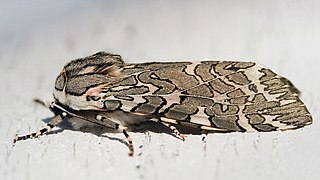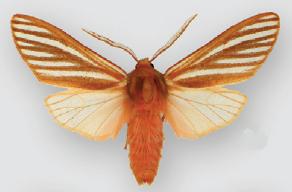Herbert Druce, FLS was an English entomologist. His collections were acquired by Frederick DuCane Godman (1834–1919), Osbert Salvin (1835–1898), and James John Joicey (1870–1932) before being bequeathed to the Natural History Museum, London. He is not to be confused with his son, the English entomologist Hamilton Herbert Druce, who also worked on Lepidoptera.

Arachnis is a genus of moths in the subfamily Arctiinae, subfamily Arctiinae. The genus was erected by Carl Geyer in 1837.
Argyroeides is a genus of moths in the subfamily Arctiinae. The genus was erected by Arthur Gardiner Butler in 1876.

Cisthene is a genus of lichen moths in the family Erebidae. The genus was erected by Francis Walker in 1854.

Lophocampa is a genus of moths in the family Erebidae. The genus was erected by Thaddeus William Harris in 1841. It contains around 75 species.

Pseudohemihyalea is a genus of moths in the family Erebidae described by Régo Barros in 1956. While the caterpillars of most species of Pseudohemihyalea feed on broad-leaved trees, the P. ambigua group has larvae that feed on conifers. Their forewing coloration has accordingly evolved to light-and-dark lengthwise striping, giving better camouflage among the slim needles of the host plants. In this, they seem to be convergent to certain geometer moths, such as Caripeta piniata or Sabulodes niveostriata.

Spilosoma is a genus of moths in the family Erebidae originally described by John Curtis in 1825. A very heterogeneous group, it is in need of review by the scientific community, as certain species probably need reclassification into their own genera.

Pyrausta is a speciose genus of moths of the family Crambidae. The genus was erected by Franz von Paula Schrank in 1802.
Euacidalia is a genus of moths in the family Geometridae described by Packard in 1873.

Procridinae is a subfamily of the family Zygaenidae.

Phryganidia is a genus of moths of the family Notodontidae. It consists of the following species:

Heterocampa is a genus of moths in the family Notodontidae, the prominents.

Hemileuca is a genus of moths in the family Saturniidae first described by Francis Walker in 1855.

Megalopyge is a genus of moths in the family Megalopygidae.

Stenoglene is a genus of moths in the family Eupterotidae from Africa. The genus was described by Felder in 1874.

Apatelodes is a genus of moths of the family Apatelodidae first described by Packard in 1864.
Dasylophia seriata, the western legume prominent, is a species of moth in the family Notodontidae. It was first described by Druce in 1887 and it is found in North America.












